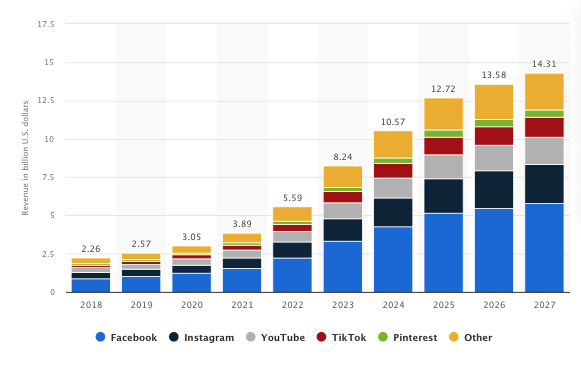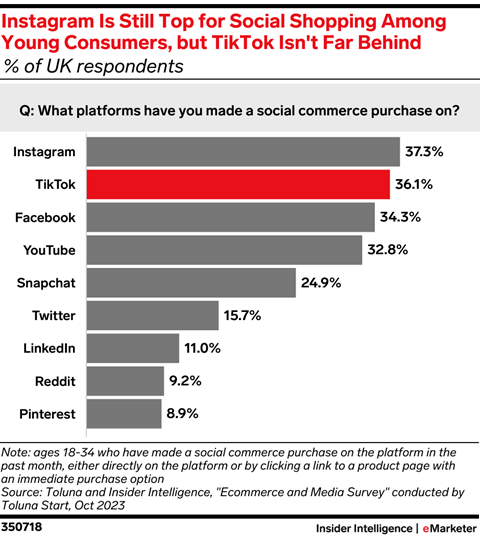Social media is no longer just a marketing channel for advertising your products. It’s a shopping destination in its own right — a place where customers can purchase directly from your brand.
Today, platforms like Instagram, TikTok, and Facebook let customers make purchases without leaving the platform — and consumers love it!
What does this mean for your retail experience? How can you take advantage of this trend? This guide reveals everything you need to know.
Let’s get started.
What is social commerce?
Social commerce is a form of eCommerce where retailers sell products directly through social media platforms.
Rather than redirecting customers to your website, as you would with social media marketing, you bring the store to them. Customers checkout directly on the social media platform, removing a substantial amount of friction from the buying process.
Ease of purchase is one reason social commerce has caught fire and is growing rapidly. The UK market is predicted to generate $10.57 billion in 2024—up from just $3.89 billion in 2021—and reach $14.31 billion by 2027.

So, what exactly does the social commerce experience look like? Here’s an example:
A potential customer scrolls Instagram and sees a sponsored post from your brand. They love the t-shirt your model is wearing, so they click the “view products” link to go to your platform-hosted product page. They choose their size, click buy, and just like that, you’ve made a social commerce sale.
How big is the global social commerce market?
We Brits love social shopping. We rank third for social shopping spend in Europe, averaging £107 per month.
But we aren’t the only consumers who shop on Instagram and TikTok. In Europe, the social commerce industry topped $18 billion in 2022 and is expected to increase 2.5 times by 2027.
It’s no different across the Atlantic. In 2023, there were nearly 107 million social shoppers in the U.S., up from 97 million in 2021. By 2028, the market will be worth $150 billion, twice the estimated value in 2024.
Social commerce is particularly popular in Asia. A staggering 84% of Chinese consumers say they have shopped on social media platforms in a market expected to grow at an annual rate of 17%.
Why adopt a social commerce strategy?
While the enormous size of the potential market may be reason enough for brands to jump head-first into social commerce, it’s not the only reason. Other benefits include:
Leverage a shorter sales cycle
You want to make it as easy as possible for customers to make a purchase, right? Well, social commerce removes enormous amounts of friction from the buyer journey by letting customers checkout without leaving the app.
It also removes one of the biggest issues with social media marketing — customers not being able to find a product they see advertised on social media. They don’t have to hunt around your eCommerce store or Google the product name, the purchase is just a click or two away.
Reach a larger audience
There’s no doubting the reach of social media platforms, especially at a time when search engines are particularly volatile, and brands may be struggling to generate a steady stream of traffic.
By running social commerce ads on platforms like Facebook and Instagram, you can put your products in front of millions of potential customers in just a few clicks. That can mean instant sales, a benefit that starkly contrasts other marketing channels like SEO.
It’s also an incredibly easy way of reaching international audiences. You don’t have to worry about localising your entire store when international customers can make a purchase through social media platforms that do all of the heavy lifting.
Get more data
It’s not just revenue that you can generate using social commerce. Every social media platform provides brands with a wealth of user behaviour data — insights you can use to improve all of your marketing efforts.
For example, analytics can show you which items users clicked on most, which products converted best, and which items caused the most cart abandonments.
Build trust with social proof
Social commerce offers brands a way to fast-track customer loyalty initiatives and build trust quicker than ever before. The inherent social setting of social commerce means your ads automatically attract social proof in the form of likes, comments and shares.
The tagging functionality of many platforms also makes it easier for influencers and other creators to advertise your products directly, rather than talking generally about them or sending followers to an affiliate link.
What are the top social commerce platforms?
Excited to give social commerce a try? Here’s how social commerce works on the leading platforms.
Instagram is the top social commerce platform for young consumers, with 37.3% of people aged 18-34 making a purchase on the platform in the past month.

Getting started with Instagram Shopping is quick and easy. If you have a business profile, you can create a customisable storefront that will act as a collection of your products. Each product gets its own page, which induces product images, details and pricing.
Instagram provides several ways to promote your products, including Shopping Tags (which lets you tag products in stories and posts), the Shop tab (which acts as a product discovery tool) and creating an Ad for your products.
TikTok
If you want to stay ahead of the trend, setting up a TikTok shop is a must. In 2023, the platform was the most shopped social media channel, with users making an average of 10 purchases on it compared to nine on Meta-owned platforms.
There are currently four ways to sell your products on TikTok:
- Short videos
- Live streaming events
- In-app storefronts
- The Shop Tab
Unfortunately, TikTok shopping isn’t available in every country. Currently, you can only sell to customers in the UK, the U.S., Indonesia, Malaysia, the Philippines, Singapore, and Thailand.
Facebook makes it easier than any other platform to get started with social commerce. Its tool, Facebook Shops, lets you set up a store for free within your Facebook business profile.
Better still, if your eCommerce platform is a Facebook partner platform, you can automatically sync your entire inventory. Partner platforms currently include Shopify and Magento.
Even if your platform isn’t listed, you can still upload all your products using a spreadsheet.
Facebook helps users organically discover products they love via the Facebook Shop tab in the mobile app. Of course, you can also advertise your products using Facebook’s ad platform or post links organically from your profile.
If users find something they love, they can make a purchase via the app or on your website. All customer communication happens via the Messenger app, keeping everything in one place.



Social commerce trends and best practices for 2024
Here are three trends to help you maximise social commerce shopping in 2024 and beyond.
Social search optimisation will become key
As social commerce becomes more popular (and therefore more competitive), it will be increasingly important to use social search optimisation to make it as easy as possible for users to find your products.
Strategies to implement include:
Live shopping will become more common
Live commerce is all the rage in China. The latest data shows that the gross merchandise value of livestreaming commerce in China exceeds $520.5 billion.
Don’t expect UK revenue to come anywhere near that, but do expect live shopping to become much more common in this country and the rest of Europe. Research shows 59% of all European consumers are interested in live shopping, meaning it’s well worth giving it a go with your brand.
Make fast fulfillment a priority
One of the biggest criticisms of social commerce is the lack of brand control. For the most part, social media platforms will own almost the entire customer relationship apart from one crucial component: delivery.
But that just makes fast, efficient delivery more important than ever. That’s something you can nail by working with a specialist eCommerce logistics partner like Pro Carrier. Our delivery service is the perfect solution for brands selling locally and across borders using social commerce.
Find out more by speaking to a member of our team today.